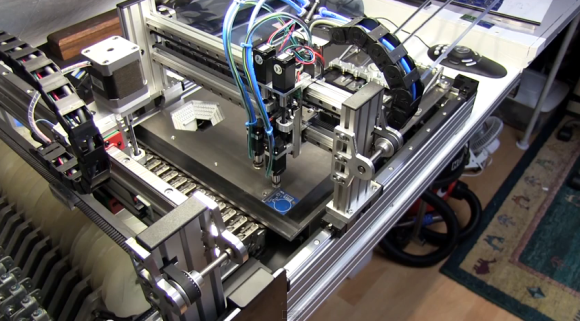
Way back in April we looked at an impressive Pick and Place machine project which wasn’t actually up and running yet. Well it looks like [Brian Dorey] has really put the pedal to the metal with this fall, posting nine project updates since September.
The previous system was working just fine but required quite a bit of user intervention to do the actual placing. So the first modifications toward the new goal centered around motorizing the gantry. There’s a lot of information on this, as well as the vacuum tweezer heads that were designed for the system. But for us it was exciting to read about the vibrating chip feeder. This uses the vibrating motor from an Xbox controller to jiggle the ICs from their tube packaging to a staging jig off the side of the build table. You can see a video of this after the break along with a demo of the entire machine at work.
[Brian] seems to favor the Xbox parts as he also used an Xbox live camera along with OpenCV to detect the parts and ensure they are lined up correctly. For the best results possible the parts need to be illuminated properly which is why he also built a rather interesting light ring using 144 red LEDs.
Vibrating parts feeder:
Board populating:
[via Hacked Gadgets]
















How does it grab the components? Suction?
There is a suction pump under the table which is routed to the picker heads via control valves.
looks great.
might not work for large scale production runs but it looks perfect for smaller batches.
i wonder what the limiting factor is for the speed.
It seems to be the smoothstepper interface which is limiting the speed as it has a 100-200ms delay every time one of the IO ports is accessed to either activate the feeder system or turn the suction on and off, this is slowing down the steppers as it keeps pausing for a fraction of a second between each move.
I’m probably wrong but… did you check with Wireshark if it has something to do with the communication? I’ve experienced some performance issues with ethernet caused by TCP delayed ACKs… so everytime i hear about 200ms delays that’s the first thing that pops in my mind :)
The delays are due to the way that Mach3 sends the commands to the interface board, by building a usb based controller for the IO ports, this should resolve the problems.
Have you looked at TinyG for this? No delays like you are experiencing. Full disclosure – that’s my project.
If you’ve seen industrial P&P machines, this one is painfully slow. A person could place the components faster after a week of practice.
i know,
but it’s speed is comparable to that of quite a few tabletop PnP’s and i would imagine that they are meant for similar uses.
a case where you need 20 boards over night would be a fine example, nothing actually prevents you from hiring people to make just that, but with a machine of this speed you could just run a large “batch” over night and have the results, wouldnt take a lot of these cases for a 3500 usd machine to actually pay for tiself, not to mention that it could work on boards and prototypes while people do something else during the day.
damn now i want one.
I’d expect it to be able to run much faster, the basic construction look similar to this http://www.youtube.com/watch?v=Ts9Daxsqmko
If you go to his youtube channel you can watch a video of the maximum speed of the axis. On the video he is moving very slow but is to show the motion of the axis
@wilmer thanks, looks a lot faster and smoother between operations.
@fonz, one of those is the exact machine i was thinking of(the 220a that is) i didnt know they could operate that fast, granted most of the people i have seen using them were anything but professional and had often only received theirs recently.
if you really wan to spend money there are even faster solutions with more pickup heads, it all comes down to how much you want to pay, the point i was trying to make was that there is a market for being able to cheaply produce smaller batches of boards either for testing or small scale hobby/commercial production.
He could have put the board closer to the components.
I’m waiting for the OpenPNP http://hackaday.com/2011/11/30/openpnp-working-to-create-an-affordable-and-completely-open-pick-and-place-machine/
Now just to achieve the speed of this probably $1M place machine
http://www.youtube.com/watch?v=SRu02F6AOmg (skip to 1:00)